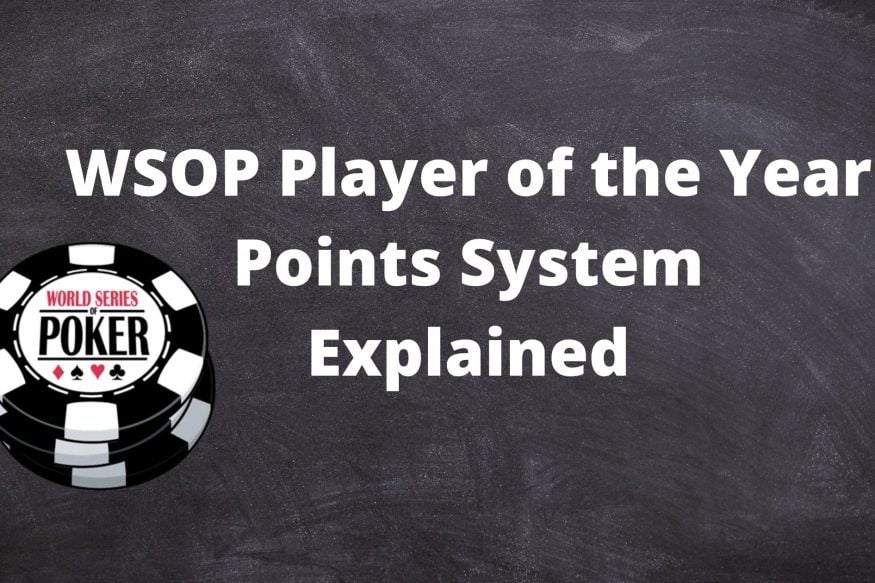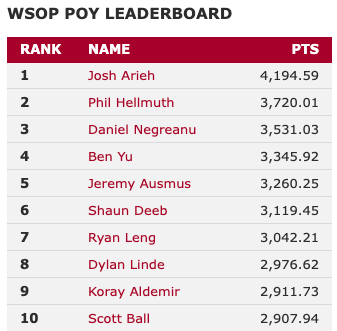How Does The WSOP Player Of The Year Points System Work?

The World Series of Poker is best known for its bracelets since winning one of these golden trinkets is a dream of many poker players, amateurs and professionals alike.
That said, there is another competition for the top pros every year at the WSOP that the general population doesn’t know too much about.
Of course, I’m talking about the Player of the Year race.
If you’ve been a World Series fan, you probably know about the POY race, as it’s often mentioned during tournament broadcasts and players themselves frequently reference it in their tweets, blog posts and vlogs.
The Player of the Year race is supposed to determine the best or the most successful player of the entire series.
Every tournament on the WSOP schedule is a part of the race, and players can earn points for the POY leaderboard.
At the end, the player with the highest number of points wins the prestigious title, alongside the cash prize, which was $15,000 for the 2021 series.
That honor went to Josh Arieh, but it was a really close race all the way to the end.
Over the years, there has been a lot of discussion on how the POY system could be improved, with some prominent figures from the poker world frequently pointing out both flaws and advantages of the current setup.
In this article, I’ll explain everything you need to know about the WSOP Player of the Year points system as it is now and will also look back at some of the criticism it has received over the years.
WSOP Player of the Year Leaderboard – The Basics
In the simplest of terms, the WSOP Player of the Year race should produce the best, most successful player of that year’s series.

To achieve this, the organizers have put a certain points system in place. It has its flaws but with so many moving parts, it’s hard to come up with a perfect solution.
In fact, after some heavy criticism during previous years, WSOP decided to change things around for the 2018 series.
They implemented big changes to the old scoring system and replaced it with a fairly successful one they’ve been using for the WSOP Circuit for several years.
The biggest change saw a significant increase in points awarded for bracelet winners while reducing the number of points for min cashes.
While WSOP still wanted to reward consistency, the overall feeling was that the discrepancy between making money and winning an event wasn’t big enough.
Of course, new rules created new problems and led to new criticism, but more on that a bit later.
First, let’s dig into the actual ranking system to see how it works. If you were following the 2021 series and weren’t sure where the movements on the POY leaderboard were coming from and why players were awarded a certain number of points, this explanation should help.
The WSOP POY Points Formula
One interesting thing about the whole Player of the Year race is that the WSOP doesn’t actually have a spreadsheet for players to refer to.
That said, every event has its own calculator, which can tell you an approximate number of points you can expect for different finishing positions.
As the organizers explain, the formula is loosely based on the WSOP Circuit POY system and scaled appropriately to accommodate for much larger fields in the World Series tournaments.
For WSOPC events, points are awarded as follows:
- Winner: 50 pts
- Runner up: 37.5 pts
- 3rd place: 30 pts, etc.
All players making the money get at least 2.5 points, and that number increases as they get deeper into an event and other players are eliminated.
For the actual World Series of Poker, these numbers are super-sized, but the organizer has tried to keep a similar ratio, allowing players to have at least a decent idea of the number of points they can expect from any individual event.
It’s important to note that almost all bracelet events count towards the Player of the Year race, with some notable exceptions.
All non-open events – i.e. events that aren’t readily available to the entire playing field – are excluded:
- Casino Employees event
- Seniors & Super Seniors events
- Ladies events
This makes sense, as counting these would give an unfair advantage to those players who can participate, so there’s never been any particular complaints about this aspect.
Since there is no spreadsheet or rulebook that players can refer to, the only way to gauge how many points one can expect from an event is by looking at the past results or using the POY calculator available on the site.
The calculator lets you pick an event and add the number of entries, which is very significant in determining the total number of points to be distributed.
Another important factor is the buy-in amount, as higher buy-in events have much bigger point pools, which clearly puts players with big bankrolls at an advantage.
For example, a win in a Super High Roller event with just 80 players would net more points for the winner than winning the $500 Reunion event with 20,000 entries.
The difference between the first and the second place is very significant as well.
A tournament winner receives double the number of points of the runner-up. This means that actual bracelets are hugely significant for the final standings.
Going down the scoreboard, the differences between all other positions are much smaller.
Of course, the runner-up will get more points than the 9th place finisher, but the difference between finishing second and third is almost insignificant from the POY point of view.
So, the current system is heavily focused on the winners and provides a big advantage for players participating in high roller and super high roller events.
These tournaments, while tough, usually feature very small fields, so players keen on winning the POY title need to get in the mix.
WSOP 2021 Player of the Year Race & New Criticism
Remember how I mentioned that WSOP changed things around and instituted a new system that gave winners bigger rewards?
Well, it turns out this system isn’t perfect either, as it doesn’t reward consistency enough.
We’ve seen a perfect example of this at the 2021 World Series of Poker, where legendary Phil Hellmuth put up perhaps his best performance in all the years we’ve watched him play the series.
The “Poker Brat” came prepared and, somewhat surprisingly, posted a bunch of great results in non-Hold’em events.
Hellmuth booked one win, two runner-up finishes, a 4th, a 5th, and several more deep runs.
Whether you’re a “Poker Brat” fan or not, this was truly amazing to watch, and it seemed like he was poised to run away with the Player of the Year title, one of the rare accolades still missing from his poker résumé.
In the end, though, he was denied by Josh Arieh, who also had a great series and is a great player in his own right.

But what made the biggest difference was that Arieh was able to ship two bracelets in 2021 against Hellmuth’s one victory.
If Hellmuth could have converted either of his two runner-up finishes into a win, it would probably be a different story.
To his credit, he was a gentleman about it and didn’t try to come up with reasons why he should have won. The rules are as they are, and no matter how you look at it, Arieh is a deserving winner.
However, this begs the question of whether the current POY system needs some changes?
A Problem With No Perfect Solution
Over the years, WSOP has tried changing and tweaking things several times. After all, they don’t have a particular interest in rewarding the POY title to any specific player.
In fact, if anything, they’d probably be better served if it went to someone as famous as Hellmuth as it’s basically free advertising.
So, on their part, the organizers would probably love to have the perfect system in place where the best, most deserving of all players out there takes home the accolade.
The problem is there is no such system – as shown by the 2021 series.
Both Hellmuth and Arieh put in a great performance and are both excellent players, but there can only be one winner.
The biggest issue that’s been discussed repeatedly is that of consistency over singular results, and finding the right balance is simply hard.
On the one hand, it seems natural to reward someone who strings a series of great results throughout all tournaments.
On the other, if someone wins two or three tournaments, even if their other results aren’t great, those wins need to be appropriately rewarded.
After all, in tournament poker, it’s always the winner who takes home the lion’s share of the prize pool, so why should the Player of the Year race be any different?
So, while there is some room to make the system better in this regard, I’d say the current one is pretty fair, even if not perfect.
Another, perhaps bigger issue, is that of buy-ins.
Is it really fair to have huge buy-in tournaments feature so many points despite small fields? Even if playing against some of the best, you’re much more likely to win in a 50 or 100-player event than you are in a 5,000+ field.
In a way, you could see this as favoritism towards big players as you won’t see an average Joe or even a solid mid-stakes grinder pony up $100K to play in one of these.
I guess opinions on this particular topic differ, but I don’t see a huge problem with it.
The WSOP Player of the Year title isn’t something that should go to just anybody.
The money that comes with it is relatively small, especially given the kind of results you have to post to win, so it’s primarily about prestige.
While there is no reason for poker to be exclusive, I’d say that we can allow for an exception in this particular category.
If the likes of Negreanu, Hellmuth, and others from that group are favorites to win every year, so be it. They’re the kind of names you think of when someone mentions the Player of the Year, anyway.
WSOP 2021 Player of the Year Summary
Hopefully, this article has given you some useful insights into how the WSOP Player of the Year points system works.
It’s one of those topics that aren’t super easy to explain, mainly because there are no clear explanations from those who came up with the system in the first place.
But, at least now you have an idea of how things work and what factors are important, namely:
- Size of the field
- The buy-in amount
- The finishing position, with the winner getting the lion’s share of the points pool
To wrap this article up, I should mention that the Player of the Year race isn’t always concluded in Las Vegas.
In earlier years, players could also collect points from WSOP Europe tournaments, which were added to their final tally.
For 2021, WSOP decided not to do this and only count points from the US leg, probably in part due to COVID-19 concerns, but WSOP Europe results will likely be included for future events.


